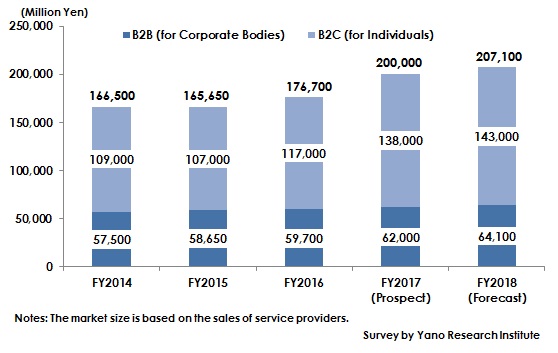No.1869
e-Learning Market in Japan: Key Research Findings 2018
e-Learning Market in Japan: Key Research Findings 2018
Yano Research Institute (the President, Takashi Mizukoshi) has conducted a survey on the domestic e-learning market and has clarified the trends of each of the B2B and B2C markets, and of the market players, as well as the future outlook.

Market Overview
The domestic e-learning market is projected to rise by 13.2% from the previous fiscal year to attain 200,000 million yen in FY2017. With the B2B market for corporate bodies to rise by 3.9% to 62,000 million yen and the B2C market for individuals to take a great stride by 17.9% to achieve 138,000 million yen, both the markets are projected to continue expanding since the previous fiscal year. With regard to the B2B market, advancement in usefulness of e-learning, stemming from: Diversification of learning tools due to wider acceptance of smartphones and tablets; improvement in telecommunication technologies; and progress in cloud environment, has raised more opportunities for user companies to use e-learning and increased the number of users, which contributed to keep the market stable. On the other hand, the B2C market has shown a rapid growth, with the size reaching as far as 100 billion yen by FY2014, boosting the size of the entire domestic e-learning market. In FY2017, in addition to steady increase of visual-based lessons at cram schools and preparatory schools, leading businesses providing correspondence educations have successfully expanded the user population by improving service systems and enhancing the course contents. The number of services as well as the users is expected to rise with the pace exceeding that of the market size, due to growing number of free-of-charge applications. Also, the forms to provide visual-based education are progressively diversifying, such as the learning courses with visual explanations and online coaching partly included, and as the courses mixed with real coaching, and etc.
Noteworthy Topics
Appearance of AI-Used Learning Courses
In recent years, there have been some cases (pilot cases included) of using AI (artificial intelligence) into learning courses. In the coming future, such courses are likely to increase, aiming to provide adaptive learning, i.e., to provide learning services according to the level of the learners and to the level of skills.
Future Outlook
The domestic e-learning market size for FY2018 is expected to rise by 3.6% to attain 207,100 million yen. The B2B market is likely to keep the steadiness, due to invigorated investment on employee training by the customer companies, against the backdrop of favorable employment environment. As for the B2C market, although there may be some ups and downs in the performance among the market players, majority of the services are, in general, likely to be on the rise.
Research Outline
2.Research Object: e-learning system developers, architect, and distributors, e-learning contents developers, producers, and providers, companies managing and providing business training and seminars using e-learning (operators of private preparatory schools, language schools and business trainers), learning software developers, producers, and distributors, etc.
3.Research Methogology: Face-to-face interviews by the expert researchers, survey via telephone/FAX/email, and literature research
What is the e-Learning Market?
The e-learning market in this research indicates a form of education services provided through internet and other networks. The learning methods using gaming devices and software for PCs are not included. The e-learning contents ranges extensively from business, academic subjects, languages, IT technologies, qualification acquisition, to various cultural and general knowledges.
Published Report
Contact Us
The copyright and all other rights pertaining to this report belong to Yano Research Institute.
Please contact our PR team when quoting the report contents for the purpose other than media coverage.
Depending on the purpose of using our report, we may ask you to present your sentences for confirmation beforehand.